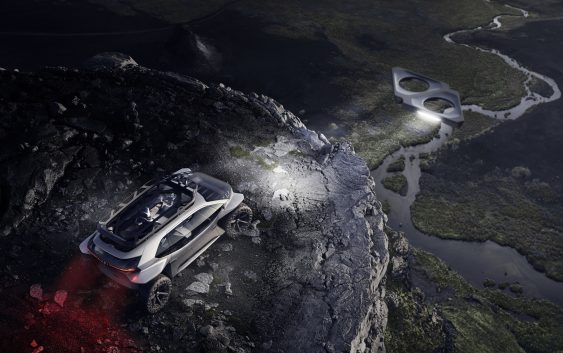Audi parent company Volkswagen recently unveiled its concept car the Audi AI Trail, an electric off-roader for the future of road transport.
The Audi AI: TRAIL quattro is a comprehensive concept for sustainable mobility off the beaten track. whether this would go into production or not is early days but it gives us a look at one-way drones can be implemented into cars over the next few years as we emerge int a new decade of innovation.
Eyes in the sky
Mobility and multifunctionality are features of the Audi AI:TRAIL’s light sources as well. Instead of conventional headlights, self-contained light sources sit below the A-pillars and can shine both outward and inward. These LED elements are dimmable and adjustable and can be used as interior lighting as well as for lighting the vehicle’s path. The rear light operates in a similar way. Extending across the full width of the rear section, this element can be used to illuminate the luggage compartment and as distinctive signature lighting for the exterior.
Instead of conventional low beams and high beams, the Audi AI:TRAIL is equipped with a total of five rotorless, triangular, electrically operated drones with integrated matrix LED elements. They are capable of landing on a roof rack or directly on the roof of the vehicle, and docking onto the inductive charging elements.
The flying objects are Audi Light Pathfinders, which generate their lift in the same way as bladeless fans produce their air flow. Thanks to their markedly lightweight design, they can fly ahead of the AI:TRAIL, consuming comparably little energy in the process, and illuminate the path ahead, thereby replacing headlights entirely. If desired, the on-board cameras generate a video image that can be transmitted to the display in front of the driver via Wi-Fi, turning the Pathfinders into eyes in the sky.
When the AI:TRAIL is stationary, the drones can also illuminate the surrounding area from their position on the roof; for example, when the occupants are enjoying a picnic next to the vehicle. They can also illuminate the interior through the transparent panoramic roof if the occupants prefer to remain inside the vehicle.
The drones, which are coordinated fully automatically by the AI:TRAIL, usually fly at least in pairs. If necessary, they can also provide additional light intensity or illuminate the area around the vehicle by coming together to form groups of up to five drones. The occupants can simply use control software on their smartphones to set their desired scenario.
The Audi Light Companion is just as easy to use. This is a light source that is shaped like a large flashlight but has a much more extensive range of functions. It is normally magnetically attached to the front side of the seat, where it acts as ambient lighting. However, you can also take the Light Companion with you when you leave the AI:TRAIL, and this is when it really shows what it can do. Integrated in its housing are three legs that can be used to stand the light in place and turn it into a campfire light or a close-range floodlight. The housing also accommodates several cameras that can scan the way ahead or take videos of the scenery, which can then be uploaded directly so social media.
However, that is not the end of the Audi Light Companion’s talents. When integrated with the AI:TRAIL’s navigation system, it is capable of projecting directional symbols and even written information onto a route and thereby helping AI:TRAIL users to find their way around when hiking.



